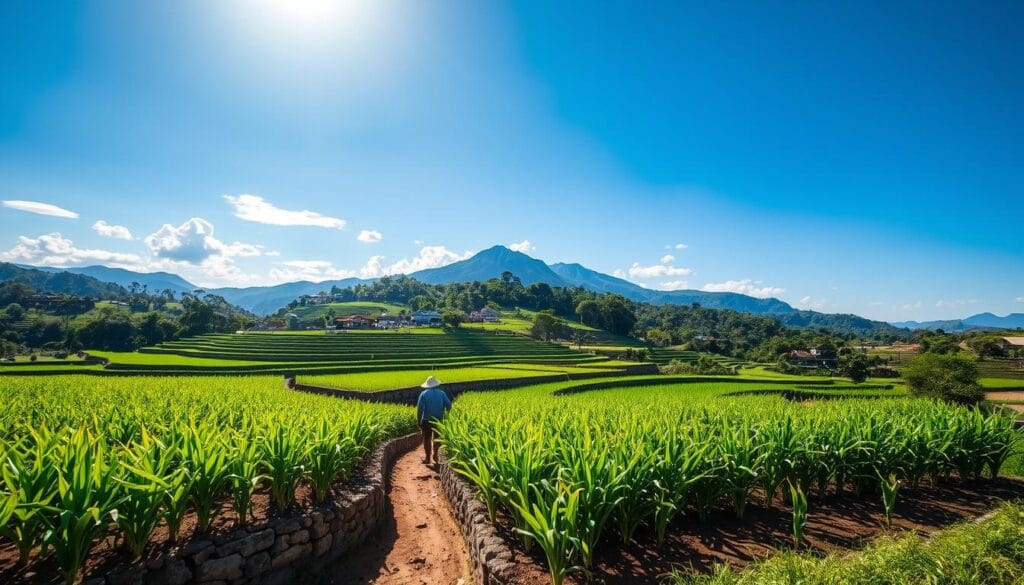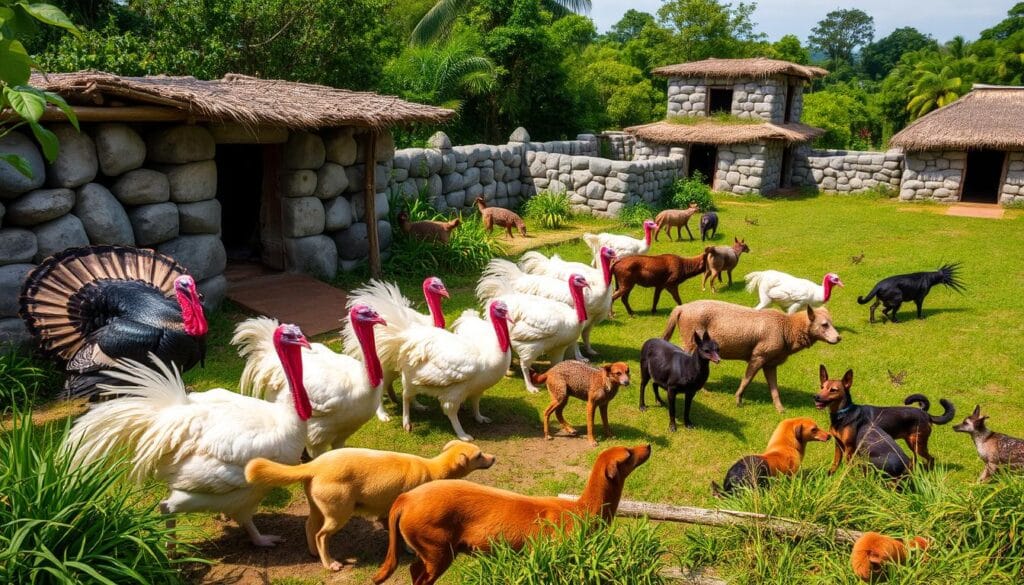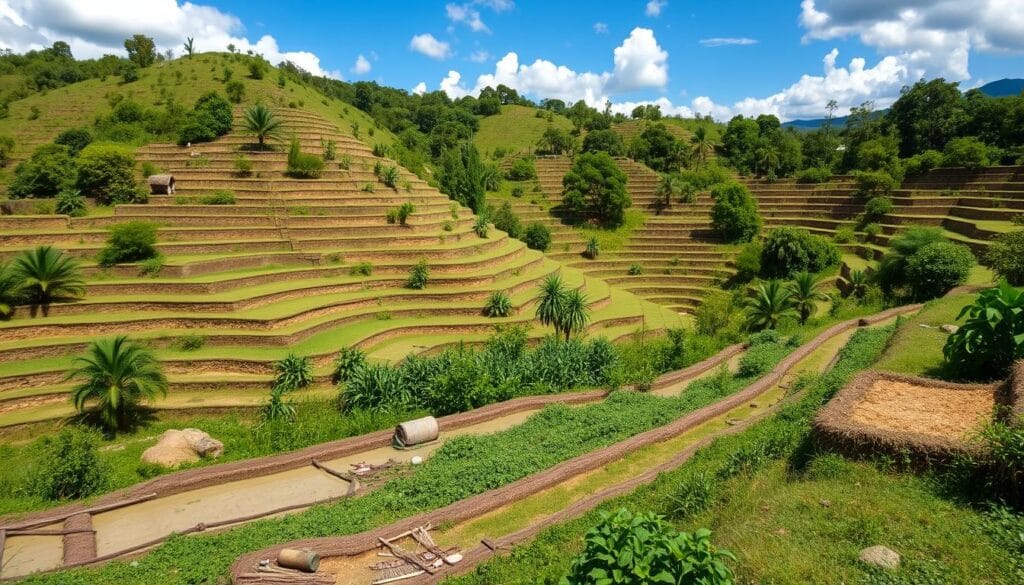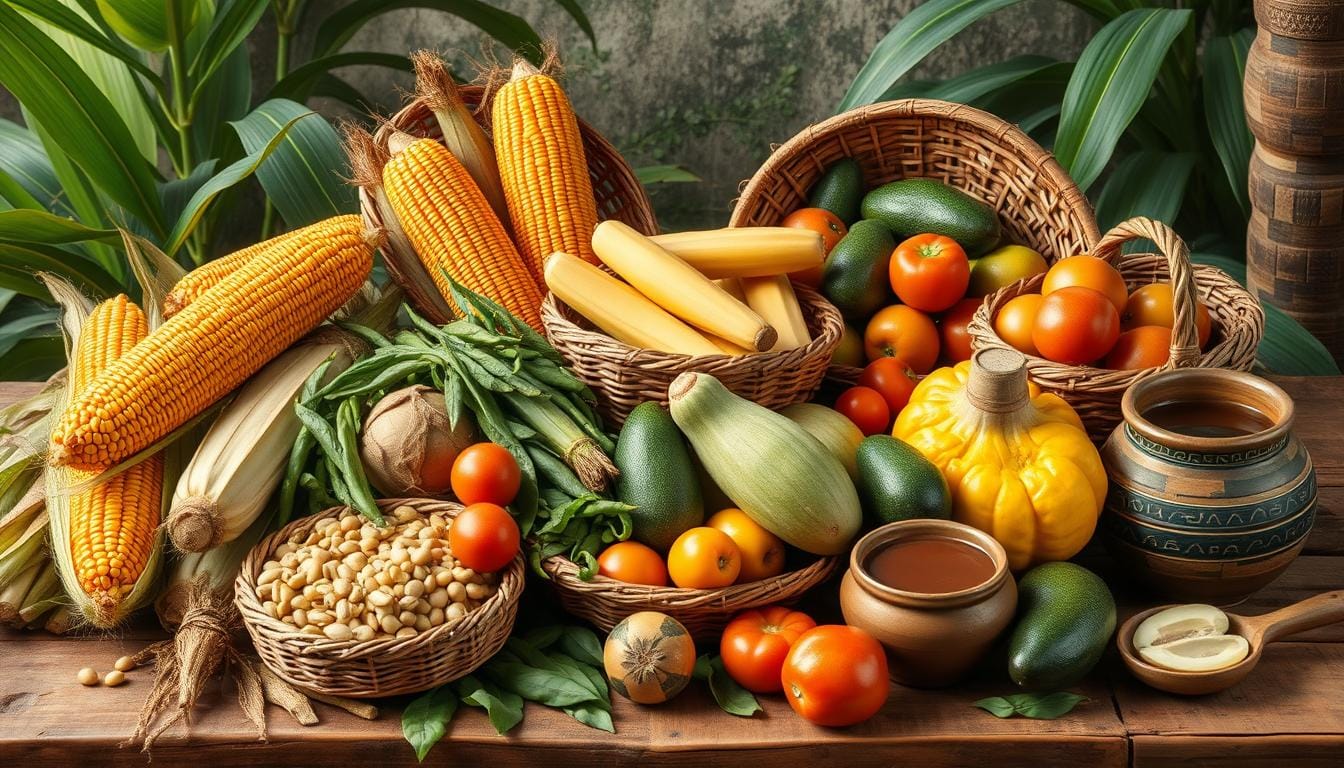Maize was the heart of the Mayan diet. It was more than just food; it was a key part of their culture. Archaeologists found evidence of maize’s importance dating back to 4500 BP.
The Mayans ate mainly maize, squash, beans, and chili peppers. Maize was the most important. Their myth says people were made from corn dough, showing maize’s significance.
Researchers found out how the Mayans made maize better to eat. They used nixtamalization. This method made the grain more nutritious and helped avoid diet problems. It shows the Mayans’ advanced knowledge of farming.
Learning about the Mayan diet shows their deep understanding of nutrition. Maize was not just food; it was their culture and spirit.
Overview of Maya Civilization and What Was the Most Important Food That the Mayans Ate?
The Maya civilization become a superb society deeply rooted in agricultural practices. These practices shaped their complete tradition. They transformed challenging landscapes into productive agricultural zones across Mesoamerica.
Maya agriculture became extra than just a way to survive. It became a complicated system of environmental interplay and cultural expression. The Mayans advanced innovative strategies to maximize food production in various geographical settings.
If you’re interested in how geography influenced ancient diets, explore the history of Galena chicken recipes, a modern twist on traditional methods that highlights how local ingredients shaped cuisine
Importance of Agriculture in Mayan Culture
Agriculture became the cornerstone of Mayan society, with an astounding ninety% of the population concerned in farming. Their agricultural practices were complex and adaptive:
- Developed state-of-the-art land control strategies
- Utilized scale down-and-burn agriculture for soil rejuvenation
- Implemented crop rotation techniques
- Created advanced water collection systems
What Was the Most Important Food That the Mayans Ate? – Influence of Geography on Food Choices
The Mesoamerican diet of the Maya was deeply influenced by their geographical diversity. Different regions offered unique agricultural opportunities:
| Region | Primary Crops | Key Resources |
|---|---|---|
| Lowland Areas | Maize, Beans, Squash | Fertile soil patches |
| Highland Regions | Root Crops, Amaranth | Extended land recovery periods |
| Coastal Zones | Seafood, Tropical Fruits | Marine protein sources |
By adapting to their environment, the Maya created a resilient and diverse agricultural system. This system supported their complex civilization for centuries.
The Staple Crop: What Was the Most Important Food That the Mayans Ate?
Mayan maize was more than just food. It was the heart of their civilization. Corn cultivation was at the center of Maya life, tied to their culture and beliefs.

The Maya had a special bond with maize. They started growing corn around 2500 BC. This change helped them move from a nomadic life to skilled farmers.
How What Was the Most Important Food That the Mayans Ate Shaped Their Society
Maize was key in Maya society and daily life. Some interesting facts are:
- Maize made up over 60% of their daily food
- They created more than 400 dishes using corn
- Corn was central to their religious and spiritual practices
“Maize was not just food, but a divine gift connecting humans with their gods.”
Varieties of Maize Grown by the Mayans
The Maya’s corn cultivation was advanced. They:
- Used crop rotation to keep the soil
- Developed special ways to prepare corn
- Improved corn nutrition through nixtamalization
Nixtamalization soaked maize in alkaline solution. It made nutrients like niacin available. This ensured a balanced diet and prevented protein deficiencies.
Other Key Crops in the Mayan Diet
The Maya civilization was known for its advanced farming. They grew many plants beyond maize. These crops were vital for their food and culture.
Beans: A Vital Protein Source in Addition to What Was the Most Important Food That the Mayans Ate
Black beans were a key protein for the Maya. They started growing them in southern Mexico over 7,000 years ago. The Maya grew different types of beans, like pinto, red, and black.
Squash: Nutritional Powerhouse Complementing What Was the Most Important Food That the Mayans Ate
Squash was another important crop for the Maya. They started growing it around 8000 B.C. It was full of nutrients and added variety to their meals.
Cacao: Divine Delicacy and Companion to What Was the Most Important Food That the Mayans Ate
Cacao was very special to the Maya. They thought it was a gift from the gods. It was first grown about 3,000 years ago. It was more than food; it was a symbol of their culture.
“Theobroma” – the Mayan word for cacao, literally meaning “food of the gods”
| Crop | Domestication Age | Cultural Significance |
|---|---|---|
| Black Beans | 7,000 years | Primary protein source |
| Squash | 8,000 years | Nutritional staple |
| Cacao | 3,000 years | Sacred commodity |
Learning about these crops shows the Maya’s advanced farming skills. They grew plants that were both nutritious and culturally important.
For a closer look at how these ingredients influence modern cuisine, consider exploring Mississippi meatballs, a dish that similarly blends traditional flavors with modern techniques.
The Role of Livestock in Mayan Cuisine
The ancient Maya had a smart way of getting food that went beyond hunting. They managed their livestock in a complex way that was key to their survival.

The Maya had special ways to raise animals that fit well with their farming. They chose animals carefully for their needs.
Types of Animals Raised by the Mayans
- Turkeys (ulum): Primary domesticated bird
- Dogs (pek): Raised for multiple purposes
- Occasional small game animals
Importance of Turkey and Dogs in Their Diet Complementing What Was the Most Important Food That the Mayans Ate
Turkeys were very important in Maya animal care. They were not just food but also had deep cultural meaning. Archaeology shows they were key in religious and food traditions.
| Animal | Primary Purpose | Cultural Significance |
|---|---|---|
| Turkey | Meat Source | Ritual Offerings |
| Dog | Meat and Companionship | Sacrificial Ceremonies |
*”In Maya society, animals were more than mere sustenance—they were living connections to spiritual practices and community life.”*
Even though hunting was a big way to get meat, animals helped provide a steady food source. The Maya’s skill in animal care showed their deep knowledge of farming and how to live in tough environments.
Fishing and Gathering: Supplements to Farming and What Was the Most Important Food That the Mayans Ate
The ancient Maya diet was more than just farming. They also fished and gathered wild foods to add variety to their meals. These activities gave them the protein they needed.
The Maya were skilled at getting food from their surroundings. They used both land and water, showing their ability to adapt.
Freshwater and Coastal Fishing Techniques
Fishing was key for the Maya, both in rivers and by the coast. Coastal folks got a lot of their food from the sea. Fish made up about 15% of their protein.
- Tilapia was the most common fish, making up nearly 50% of fish remains
- They used nets, traps, and even caught fish by hand
- Shellfish like conch and shrimp were also big food sources
Wild Food Gathering Practices
Gathering wild foods was a big part of the Maya diet. About 40% of rural families did this, collecting plants and small game.
| Gathered Food Type | Protein Contribution | Availability |
|---|---|---|
| Small Game | 25% of protein sources | Seasonal |
| Insects | 15% of protein intake | Year-round |
| Wild Plants | Nutritional supplements | Varied |
The Maya’s varied food gathering showed their adaptability and knowledge of nature.
The Maya were masters of survival, transforming their landscape into a complete pantry.
The Preparation and Cooking Methods
The ancient Maya were masters at turning raw ingredients into tasty dishes. Their cooking methods show a deep connection to tradition and practicality.
Archaeologists have found clay balls that got as hot as 1,300 degrees Fahrenheit. This shows the Maya had advanced cooking tech. These finds, from 1,000 years ago, highlight their skill in managing heat.
Traditional Cooking Implements
The Maya had a few key tools in their kitchens:
- Comal: A flat griddle for cooking tortillas
- Metate: A stone for grinding masa
- Clay pots for stews and broths
Stone Tools in Food Preparation
Stone tools were vital in Maya cooking. The metate was key for making masa from corn. This process, called nixtamalization, made corn more nutritious by releasing niacin.
| Cooking Method | Primary Ingredients | Cooking Technique |
|---|---|---|
| Tortilla Making | Nixtamalized corn masa | Pressed and cooked on comal |
| Tamales | Corn dough, fillings | Wrapped in corn husks, steamed |
| Pibil | Meat, spices, citrus | Slow-cooked underground |
The Maya’s cooking shows amazing creativity in making meals from local ingredients.
Rituals and Food in Mayan Society
The Maya civilization deeply intertwined meals with religious and social practices. Maya food rituals have been no longer pretty much ingesting. They have been complicated cultural expressions that connected groups to their non secular global.
Ancient Mesoamerican ceremonies frequently protected special meals practices. These food had been sacred communal reports. They bolstered social bonds and non secular ideals.
Food Offerings in Religious Practices
During sacred ceremonies, the Maya organized precise foods as divine offerings. Cocoa beans had been key in those rituals. They symbolized non secular connection and cosmic concord.
- Chocolate changed into ritually fed on throughout wedding ceremony ceremonies
- Specific meals had been prepared as sacrificial services to gods
- Ceremonial food marked crucial agricultural and spiritual cycles
The Social Aspect of Meals
Sharing meals meant more than just eating for the Maya. These gatherings strengthened community relationships and social hierarchies.
“Food was the thread that wove together Mayan social fabric” – Mayan Cultural Historian
Understanding Maya culture is richer when we see how important food was. Each meal was a story of connection, belief, and shared identity.
The Influence of Climate on Agriculture

The ancient Maya were experts at adapting to Mesoamerica’s tough climate. Their farming showed how humans can solve big challenges.
Seasons were key in Maya farming. They made detailed calendars to track planting and harvest times. These calendars were better than those of their European peers, showing the Maya’s grasp of nature.
Seasonal Crop Production Strategies
The Maya found creative ways to grow crops despite tough conditions:
- Raised field farming in wet areas
- Terrace farming in mountainous regions
- Shifting cultivation methods
- Milpa farming rotation techniques
Drought and Food Supply Challenges
Droughts were a big problem for Maya farming. They tackled this with smart strategies:
- Creating complex water management systems
- Developing crop varieties resistant to dry conditions
- Implementing land rotation practices
“The Maya did not fight nature, they worked with it.” – Archaeological Research Insights
Traditional milpa farming was very resilient. Farmers would use land for 2-3 years and then let it rest for up to 30 years. This kept the soil rich and avoided total damage.
Today, over 70,000 traditional farmers in the Yucatán face climate challenges. Their work shows the lasting value of the Maya’s farming wisdom.
Preservation Techniques Used by the Mayans
The Maya civilization was very good at keeping food fresh. They used smart ways to store food, even when it was hard. This helped them survive in Mesoamerica’s tough climate.
The Mayans came up with clever ways to keep their crops safe. They needed these methods because of the big changes in seasons.
Methods for Storing Harvested Crops
The Mayans had many ways to store their food:
- Underground storage pits for grains and seeds
- Ceramic vessels with tight-fitting lids
- Raised platforms to protect food from moisture and pests
- Ventilated storage areas to prevent spoilage
Fermentation as a Preservation Strategy
Fermentation was key for the Mayans. It made food last longer and taste better. It also made food more nutritious.
“Preservation was an art form for the Maya, transforming simple ingredients into sustainable nutrition.”
| Preservation Method | Primary Foods Preserved | Duration of Preservation |
|---|---|---|
| Underground Storage | Maize, Beans | 6-12 months |
| Fermentation | Maize Drinks (Pozol) | 1-2 weeks |
| Ceramic Vessel Storage | Seeds, Dried Fruits | 3-6 months |
The Mayans were very smart about farming. They knew how to keep food safe, even in tough places.
The Impact of Spanish Colonization on Mayan Food
The arrival of Spanish conquistadors in the 16th century changed Mesoamerican food history a lot. They brought new ways of cooking that changed the Maya’s food forever.
Spanish colonization changed Maya farming and cooking a lot. The Maya and Spanish mixed their cooking styles, creating a new food scene.
New Ingredients Introduced
The Spanish conquistadors brought many new foods that changed Maya cooking:
- Wheat and rice
- Sugar cane
- Dairy products
- New spices and herbs
Transformation of Farming Practices
Colonial influence changed how the Maya farmed. They used to farm in a way that was good for the land. But the Spanish brought new farming methods.
| Traditional Maya Practice | Spanish Colonial Introduction |
|---|---|
| Three Sisters Farming (Maize, Beans, Squash) | European Monocropping Techniques |
| Local Seed Varieties | Imported European Crop Seeds |
| Subsistence Agriculture | Commercial Agricultural Production |
The biggest change was in cacao. The Maya used it as a sacred drink. The Spanish made it sweeter by adding sugar and milk. This sweeter version became popular all over the world.
“The conquest was not just about territory, but about transforming entire cultural ecosystems, including food practices.” – Historical Food Anthropologist
These changes made Maya food different. They introduced new tastes, ingredients, and ways of cooking. These changes are part of modern Mesoamerican cuisine.
Conclusion: The Legacy of Mayan Cuisine Today
Modern Maya food keeps alive a rich culinary heritage that goes back thousands of years. Traditional dishes are a testament to the Mesoamerican culinary heritage’s enduring spirit. These dishes have made it through many cultural changes and challenges.
The sacred corn and detailed cooking methods show a deep connection to ancient farming ways. This connection is what makes Maya cuisine so special.
In Mexico, you can see the Mesoamerican culinary heritage in many restaurants and markets. Dishes like Poc-Chuc, Sopa de Lima, and Pib show how old cooking methods are kept alive. Places like Alux and El Fogon mix ancient flavors with new cooking ideas.
Exploring Mayan cuisine shows a strong cultural resilience. Ingredients like chaya leaves, achiote, and habanero peppers show how these traditions are deeply rooted. From Cancun’s street markets to fancy restaurants, the Mayan culinary legacy inspires and feeds both locals and food lovers worldwide.
Continuation of Traditional Foods in Modern Maya
Traditional ingredients and cooking methods are key in modern Maya communities. Making dishes like Chay tamales and Sikil Pak keeps ancestral food knowledge alive. These traditions are more than food; they connect us to Maya history and culture.
The Influence of Mayan Cuisine on Contemporary Culture
Mayan cuisine’s impact goes beyond local areas. New dishes like cochinita pibil tacos and Mayan shrimp and grits show how these traditions evolve. The Maya’s rich flavors and sustainable food ideas are changing global food in amazing ways.
FAQ
Q: What was the most important food in the Mayan diet?
A: Maize (corn) was key in the Mayan diet. It was more than just food; it was part of their culture and beliefs. They grew many types of maize and used a special method called nixtamalization to make it more nutritious.
Q: How did the Mayans preserve their food?
A: The Mayans had clever ways to keep food fresh. They used storage pits, ceramic jars, and fermentation. They made pozol, a fermented corn drink, to keep food good for longer. This helped them have enough food all year, even when it was scarce.
Q: What other important crops did the Mayans cultivate?
A: The Mayans also grew beans, squash, and cacao. These foods were good with maize and were very important to them. Cacao was special because it was used in ceremonies and trade.
Q: How did geography influence Mayan food choices?
A: The land where the Mayans lived shaped their food choices. Coastal areas had seafood, highlands had certain crops, and tropical zones had different farming ways. This led to different foods and farming methods in different places.
Q: What animals were important in Mayan cuisine?
A: Turkeys and dogs were important to the Mayans. They also hunted wild animals to add variety to their diet. This helped make their diet more balanced and nutritious.
Q: How did Spanish colonization impact Mayan cuisine?
A: When the Spanish came, they changed Mayan food ways a lot. They brought new foods, animals, and cooking methods. This mix of old and new created a new cuisine that was both Mayan and European.
Q: What cooking techniques did the Mayans use?
A: The Mayans cooked with traditional tools like comals for tortillas and metates for grinding maize. They cooked in ways that made their food taste better and be more nutritious.
Q: How did climate affect Mayan agriculture?
A: The Mayans were very good at farming, even with changing weather. They used methods like slash-and-burn and crop rotation to get more food. They also farmed in ways that helped them deal with droughts and other weather changes.

